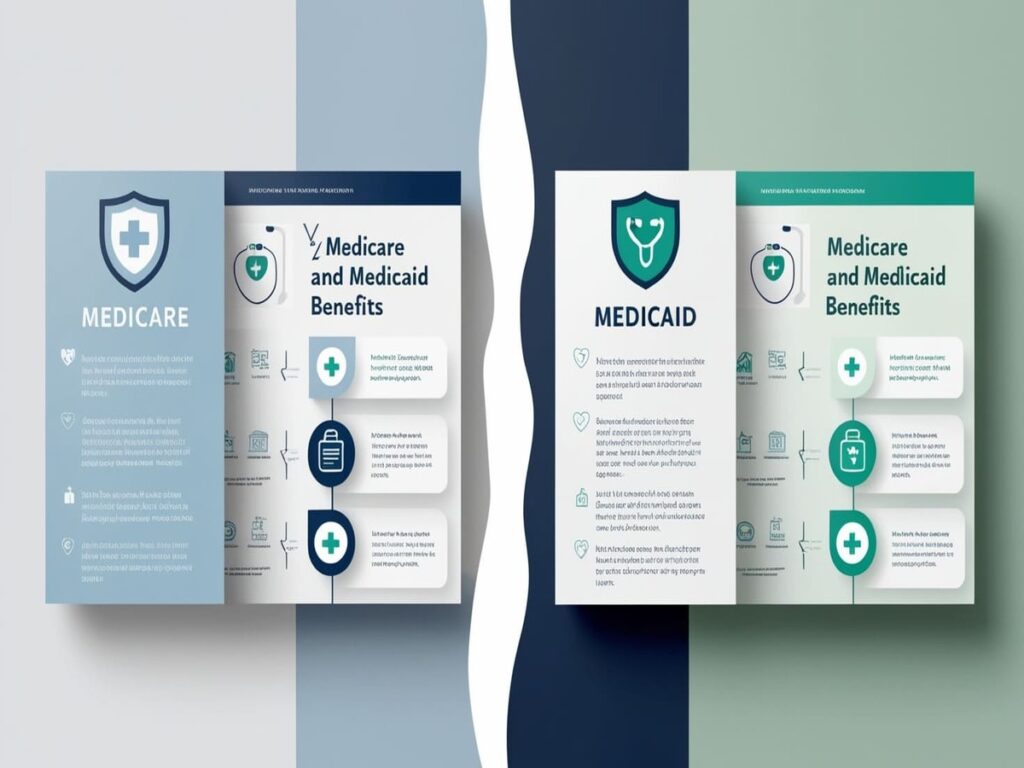When it comes to understanding the complex landscape of the American healthcare system, two programs often come up in conversation: Medicare and Medicaid. Though they sound similar and are both government-sponsored, they serve very different purposes, populations, and needs. Think of them like cousins in the same family—related but unique in their own ways. If you’ve ever found yourself scratching your head wondering which one applies to you or a loved one, you’re not alone.
Understanding the difference between Medicare and Medicaid isn’t just a matter of curiosity—it’s essential knowledge that can have real impacts on your health, finances, and quality of life. Many people make the mistake of assuming the programs are interchangeable, which can lead to missed benefits or improper coverage. Whether you’re approaching retirement, managing a chronic illness, or navigating low-income support systems, knowing the ins and outs of these programs is key.
In this article, we’re breaking down Medicare and Medicaid from top to bottom—what they are, who they serve, what they cover, and how you can access their benefits. Let’s clear up the confusion once and for all and help you make the most informed decision about your healthcare needs.
Understanding Medicare
Navigating life after 50? AARP offers expert resources on retirement, Medicare, insurance, Social Security, and more. Explore AARP’s trusted tools and guides here.
What Is Medicare?
Medicare is a federal health insurance program primarily designed for people aged 65 and older, although younger individuals with certain disabilities or medical conditions also qualify. Established in 1965 under the Social Security Act, Medicare was created to provide reliable, standardized health coverage for seniors who often faced difficulties obtaining private insurance due to age or pre-existing health issues.

Administered by the Centers for Medicare & Medicaid Services (CMS), Medicare operates uniformly across the United States. This makes it different from Medicaid, which varies significantly by state. Because it’s federally managed, Medicare offers a consistent set of benefits and enrollment rules no matter where you live.
The core idea behind Medicare is to offer older Americans peace of mind when it comes to managing their health. It’s not just about doctor visits or hospital stays—it’s about fostering a healthcare safety net during the retirement years. However, Medicare is not free, and understanding the different parts of the program is crucial to avoid unexpected bills or coverage gaps.
Who Qualifies for Medicare?
Eligibility for Medicare is relatively straightforward, but there are a few pathways to qualify. The most common way is by reaching the age of 65. As long as you or your spouse have worked and paid Medicare taxes for at least 10 years, you automatically become eligible and are typically enrolled in Part A (hospital insurance) without a premium.
But age isn’t the only factor. Individuals under 65 can also qualify if they have certain disabilities, such as end-stage renal disease (ESRD) or amyotrophic lateral sclerosis (ALS). After receiving Social Security Disability Insurance (SSDI) for 24 months, most people become eligible for Medicare automatically.
There are also provisions for people with specific health conditions, allowing them to bypass the typical waiting period. So even if you’re not yet a senior, chronic or severe health issues can make Medicare an option worth exploring.
And here’s a common pitfall to watch for: being eligible doesn’t mean you’re automatically signed up for every part of Medicare. You’ll still need to make decisions about whether to enroll in Parts B, C, and D, and whether to get supplemental insurance to cover what Medicare doesn’t.
Parts of Medicare
Medicare is split into four main parts, each serving a specific function. It’s like building blocks that create a full picture of your healthcare coverage.
Medicare Part A (Hospital Insurance)
Part A covers inpatient hospital stays, care in a skilled nursing facility, hospice care, and some home health care. Most people don’t pay a premium for Part A if they’ve worked long enough, but there are deductibles and coinsurance costs. It’s the foundation of Medicare and usually kicks in first when you need serious medical attention.
Medicare Part B (Medical Insurance)
Part B focuses on outpatient care, such as doctor visits, preventive services, lab tests, and medical equipment. Unlike Part A, Part B requires a monthly premium and usually involves co-pays and deductibles. Together, Parts A and B are often referred to as “Original Medicare.”
Medicare Part C (Medicare Advantage)
Think of Part C as a bundled alternative to Original Medicare. These are plans offered by private insurers approved by Medicare that include Part A, Part B, and often Part D (prescription drugs), plus additional benefits like vision or dental. While it adds convenience, plan options and costs can vary widely.
Medicare Part D (Prescription Drug Coverage)
Part D helps cover the cost of prescription medications. It’s optional but essential for anyone on regular medications. Like Part C, it’s provided by private insurers, and you’ll need to choose a plan that aligns with your prescription needs.
👉 Learn More Best Medicare Advantage Plans in Florida
Understanding Medicaid
What Is Medicaid?
Medicaid is another essential pillar of the American healthcare system, but it serves a very different purpose compared to Medicare. Medicaid is a joint federal and state program designed to provide health coverage to individuals and families with low income. While Medicare focuses on age and disability, Medicaid is primarily income-based, although it also supports certain vulnerable groups regardless of their income.
Established in 1965 alongside Medicare, Medicaid is administered at both the federal and state levels, which means the specific benefits, coverage, and eligibility requirements can vary widely from one state to another. The federal government provides guidelines, funding, and oversight, but each state customizes its own Medicaid program to meet the needs of its residents.
One of the most significant aspects of Medicaid is its role in filling the healthcare gaps for populations that would otherwise go uninsured. This includes children, pregnant women, seniors who need long-term care, and people with disabilities. The Affordable Care Act (ACA) further expanded Medicaid eligibility in many states, allowing more adults without children to qualify based solely on income.
In simple terms, Medicaid is the safety net that ensures even the most economically vulnerable among us can access necessary healthcare services, from routine check-ups to hospital stays and even long-term care in nursing homes.
Who Qualifies for Medicaid?
Qualifying for Medicaid depends largely on your income and household size, although some categories like disability or pregnancy can grant eligibility regardless of income in many states. Because Medicaid is a state-run program, the criteria differ depending on where you live, which makes it essential to check your state’s specific guidelines.
Generally, the following groups are eligible for Medicaid:
- Low-income adults
- Pregnant women
- Children and teenagers
- Seniors (especially those also eligible for Medicare)
- People with disabilities
States often use a percentage of the Federal Poverty Level (FPL) to determine eligibility. For example, a state might offer Medicaid to individuals earning up to 138% of the FPL, which is about $20,120 annually for a single person in 2024.
In addition, there are other pathways to qualify. If you’re receiving Supplemental Security Income (SSI), you typically qualify for Medicaid automatically. States also have flexibility to create “medically needy” programs, allowing individuals with high medical expenses to qualify even if their income is slightly above the threshold.
The takeaway? If you’re struggling financially or managing a chronic illness, Medicaid could be a lifeline. And thanks to expansion in many states, more people than ever are qualifying.
What Does Medicaid Cover?
Medicaid covers a broad range of healthcare services, many of which are essential for maintaining long-term health and managing chronic conditions. While there are federally required services that all states must cover, each state has the flexibility to add optional benefits.
Federally mandated services include:
- Inpatient and outpatient hospital services
- Physician services
- Laboratory and x-ray services
- Home health services
- Nursing facility services
- Family planning
- Pediatric and family nurse practitioner services
Optional services that many states cover include:
- Prescription drugs
- Dental and vision care
- Physical therapy
- Hospice care
- Case management
- Chiropractic care
One of the key strengths of Medicaid is its comprehensive coverage of long-term care, something Medicare generally does not cover beyond short-term skilled nursing. For elderly individuals needing long-term nursing home care or home-and-community-based services, Medicaid is often the only option.
However, the quality and availability of optional services can vary significantly by state. Some states offer very generous Medicaid benefits, while others may impose stricter limits, especially when state budgets are tight. Still, for many, it’s the only route to essential care.
👉 Learn More Medicare Myths Debunked: What Every 50+ Individual Should Know
Key Differences Between Medicare and Medicaid
Understanding the core differences between Medicare and Medicaid is crucial to avoid confusion and ensure you’re getting the healthcare coverage you need. Though both programs were created around the same time and are managed by the Centers for Medicare & Medicaid Services (CMS), they are different in terms of who they serve, what they cover, and how they operate.
Eligibility Requirements
This is perhaps the most significant difference between the two programs. Medicare is primarily based on age (65 and older) or disability status. You don’t have to be low-income to qualify, and most people are automatically enrolled when they meet the criteria.
In contrast, Medicaid is designed for low-income individuals and families. It considers income levels, household size, and sometimes assets. Some groups—like pregnant women or people with certain disabilities—are prioritized, even if their income is above the typical cutoff in some states.
Quick Recap:
- Medicare = age/disability-based
- Medicaid = income/need-based
Coverage and Benefits
While there is some overlap, the scope and type of coverage offered by each program differ.
Medicare provides:
- Hospital stays (Part A)
- Outpatient care and preventive services (Part B)
- Prescription drugs (Part D)
- Optional private plans with extra benefits (Part C)
Medicaid offers:
- All medically necessary hospital and outpatient care
- Prescription drug coverage (in most states)
- Long-term care (like nursing homes)
- Extra benefits like dental and vision (depending on the state)
In many cases, Medicaid can provide more comprehensive coverage, especially for long-term services that Medicare simply doesn’t cover.
Cost and Out-of-Pocket Expenses
This is where many people are surprised. Medicare isn’t free. You typically pay premiums for Part B and Part D, and there are deductibles and coinsurance amounts. Without supplemental insurance (like Medigap), those out-of-pocket costs can add up quickly.
Medicaid, on the other hand, is designed to be affordable. Most services are free or come with very minimal co-pays. For low-income individuals, Medicaid is often the most financially accessible form of health insurance available.
Administration and Regulation
Another major difference lies in how these programs are run. Medicare is a federal program, so it’s the same across the U.S., no matter where you live. The rules, benefits, and regulations are standardized.
Medicaid, by contrast, is a state-federal partnership, meaning each state runs its own version of Medicaid within federal guidelines. This makes it highly variable—your experience with Medicaid in New York could be very different from someone’s experience in Texas.
Can You Have Both Medicare and Medicaid?
Dual Eligibility Explained
Yes, it’s absolutely possible to qualify for both Medicare and Medicaid at the same time—this is called “dual eligibility.” People who fall into this category are typically individuals who are low-income and also either over the age of 65 or living with a disability. These individuals get the best of both worlds: the hospital and medical coverage of Medicare, along with the extended services and low out-of-pocket costs offered by Medicaid.
Dual eligibility is incredibly helpful because it addresses many of the gaps found in each individual program. Medicare alone doesn’t cover long-term care, vision, dental, or hearing in many cases, but Medicaid can often step in to fill those gaps. If you qualify for both, you’re essentially layering one safety net on top of another.
One of the lesser-known perks of being dual eligible is that Medicaid may even pay for your Medicare premiums, deductibles, and coinsurance, reducing your out-of-pocket expenses to nearly zero.
Benefits for Dual Eligible Individuals
Being dual eligible brings several important advantages that can significantly enhance access to healthcare. Here’s what that might look like in real life:
- Comprehensive Coverage: You’ll receive all Medicare benefits (Parts A, B, and possibly D) and also the extended services that Medicaid offers in your state.
- Lower Costs: Medicaid often picks up where Medicare leaves off, covering co-pays, deductibles, and even premiums.
- Long-Term Care: This is a big one—Medicaid pays for long-term care services in nursing facilities or at home, which Medicare doesn’t cover for more than 100 days.
- Prescription Drugs: Medicaid ensures you have access to the medications you need, often at no cost or for just a few dollars.
If you or a loved one might be dual eligible, it’s worth exploring right away. The process does require applying for both programs separately, but the benefits are well worth the paperwork.
Coordination of Care and Costs
Managing two insurance plans can sound complicated, but the programs are designed to coordinate efficiently. Medicare is considered the primary payer, meaning it covers services first. Medicaid then acts as a secondary payer, covering any leftover costs that Medicare didn’t pick up—things like deductibles or certain services not covered by Medicare.
This layered approach ensures that dual eligible individuals get comprehensive care with minimal out-of-pocket spending. Some states also offer special programs called Dual Eligible Special Needs Plans (D-SNPs), which combine Medicare and Medicaid benefits into one managed care plan. These plans are designed specifically for people who qualify for both programs and often include case managers to help coordinate care.
👉 Compare Medicare plans with AARP and find the right fit for you
Common Misconceptions
Despite their importance, both Medicare and Medicaid are widely misunderstood. These misconceptions can lead to confusion, missed benefits, and poor decision-making when it comes to healthcare choices.
“Medicare Covers Everything” Myth
One of the most common misunderstandings is the belief that Medicare covers all medical expenses once you’re 65. While Medicare does provide extensive coverage, it doesn’t pay for everything. Here are a few major things Original Medicare doesn’t fully cover:
- Long-term care (like nursing homes or custodial care)
- Dental services such as cleanings, fillings, and dentures
- Vision care, including routine eye exams and glasses
- Hearing aids
You’ll also still be responsible for premiums, deductibles, co-pays, and coinsurance unless you have supplemental insurance. Medicare provides a strong foundation, but it’s not a golden ticket to free healthcare.
“Medicaid Is Only for the Poor?”
Another common myth is that Medicaid is only for people living in extreme poverty. While Medicaid does primarily serve low-income individuals and families, it also supports a wide range of other groups:
- Seniors who have exhausted their resources paying for long-term care
- People with disabilities, regardless of income
- Pregnant women and children, often in higher-income brackets than you’d expect
In states that have expanded Medicaid under the ACA, even childless adults earning up to 138% of the Federal Poverty Level may qualify. Medicaid isn’t just a program for the poor—it’s a critical support system for many Americans at different life stages.
Confusing the Two Programs
It’s incredibly common for people to confuse Medicare and Medicaid, especially when dealing with aging parents or their own retirement planning. Some assume they’re interchangeable; others don’t realize you can qualify for both. Here’s a quick way to remember the difference:
- Medicare = Care for the elderly (or disabled)
- Medicaid = Aid for those with low income
Knowing which program applies to you can help you avoid costly mistakes and ensure you’re receiving all the benefits you’re entitled to.
How to Apply for Each Program
Applying for Medicare
If you’re approaching your 65th birthday, applying for Medicare is a relatively simple process. In fact, many people are automatically enrolled in Part A and Part B if they’re already receiving Social Security benefits. If not, you’ll need to enroll manually through the Social Security Administration.
Steps to apply:
- Visit the Social Security website.
- Fill out the online application (it takes about 10 minutes).
- Choose your coverage options (Parts A and B, or add Parts C and D later).
- Receive your Medicare card in the mail.
It’s important to enroll during your Initial Enrollment Period (three months before and after your 65th birthday month) to avoid late penalties.
Applying for Medicaid
Unlike Medicare, Medicaid enrollment goes through your state’s government. The application process and eligibility rules vary, so you’ll need to visit your state’s health department or Medicaid website.
Typical steps include:
- Visit your state’s Medicaid portal (or Healthcare.gov if your state uses it).
- Provide documentation for income, assets, and household size.
- Wait for approval or further documentation requests.
- Choose a managed care plan if applicable in your state.
If you’re unsure whether you qualify, apply anyway. Many people wrongly assume they won’t be eligible and miss out on crucial benefits.
Tips for a Smooth Application Process
- Gather documents early: Have your Social Security number, income records, and insurance details ready.
- Don’t delay: Applying late can result in penalties or delayed coverage.
- Seek help if needed: Many nonprofit organizations and government offices offer free help to guide you through the process.
- Review your options annually: Plans and eligibility can change from year to year.
Impact on Seniors and Low-Income Families
Seniors Relying on Medicare
For millions of older Americans, Medicare is the lifeline that ensures they can age with dignity and access quality healthcare. After retirement, when most people are no longer covered by employer-sponsored health insurance, Medicare steps in to provide a consistent and reliable solution.
Many seniors rely on Medicare for:
- Routine doctor visits
- Hospitalizations
- Preventive screenings
- Management of chronic conditions like diabetes or heart disease
But here’s the reality: while Medicare covers a lot, it doesn’t cover everything. That’s why many seniors opt for Medicare Supplement Insurance (Medigap) or Medicare Advantage plans to fill the gaps—things like co-pays, deductibles, and services not included in Original Medicare.
For those with limited income, Medicaid acts as a safety net on top of Medicare. This combination ensures that seniors aren’t forced to choose between paying their utility bill and affording life-saving medications. In an aging society, the interaction between these two programs is more critical than ever.
Medicaid’s Role in Supporting Families and Children
On the flip side, Medicaid plays a vital role for families with young children, single parents, and individuals facing economic hardship. Children, in particular, benefit greatly from Medicaid coverage, especially through the Children’s Health Insurance Program (CHIP), which extends coverage to those who earn too much to qualify for Medicaid but still struggle with healthcare costs.
Medicaid supports families by covering:
- Pediatric visits
- Vaccinations
- Prenatal and maternity care
- Emergency room visits
- Mental health services
For many low-income households, Medicaid is the only way to afford proper healthcare. Without it, preventive care falls by the wayside, leading to more expensive health issues down the line. Medicaid isn’t just a benefit—it’s a critical component of public health in the U.S.
👉 Join AARP today and unlock exclusive retirement benefits
Recent Changes and Updates
Legislative Updates
In recent years, there have been several major legislative changes affecting both Medicare and Medicaid. From the Affordable Care Act (ACA) expanding Medicaid eligibility in many states, to newer discussions around expanding Medicare to include more services like dental and vision—these programs are constantly evolving.
One major policy under consideration is Medicare for All, which seeks to extend Medicare to every American, but that’s still in debate. Meanwhile, Medicaid continues to face political scrutiny, with ongoing discussions around work requirements and eligibility restrictions in some states.
COVID-19’s Impact
The COVID-19 pandemic highlighted the vital role that Medicare and Medicaid play in public health. During the crisis, both programs expanded access to telehealth services, making it easier for people to get care from home. States also temporarily suspended disenrollments from Medicaid, helping millions maintain coverage during uncertain times.
Federal emergency funding helped keep both programs stable, but as the pandemic winds down, some of those temporary protections are ending. This could mean millions may need to reapply or verify eligibility again.
Ongoing Healthcare Reform
Healthcare reform remains a hot topic in Washington, and any proposed changes to Medicare or Medicaid could have significant implications. From lowering the Medicare eligibility age to increasing Medicaid reimbursements to doctors, reforms aim to increase access while managing costs. Staying informed is essential, especially since changes can directly affect your coverage or premiums.
Choosing the Right Program for You
Evaluating Your Needs
Choosing between Medicare, Medicaid, or both comes down to your personal situation—your age, income, health conditions, and living arrangements. Start by assessing your needs:
- Are you 65 or older?
- Do you have a disability or chronic illness?
- Are you struggling financially?
- Do you need long-term care?
Answering these questions can help determine which program fits you best.
Consulting Healthcare Advisors
If you’re confused, you’re not alone. Medicare and Medicaid both have complex rules and many moving parts. That’s why it’s wise to consult with a licensed insurance agent, a State Health Insurance Assistance Program (SHIP) advisor, or a caseworker from your local Medicaid office. These professionals can help you navigate enrollment, plan comparisons, and supplemental coverage.
Using Online Tools and Resources
Technology makes research easier than ever. There are dozens of helpful websites to guide you through the process. Some great places to start:
- Medicare.gov
- Medicaid.gov
- Healthcare.gov
- State-specific Medicaid portals
- Benefits check tools and coverage estimators
Educate yourself and review your options carefully. What works today may not be the best option in a year, so regular check-ins are important.
Conclusion
Medicare and Medicaid may sound similar, but they serve distinctly different roles in America’s healthcare system. Medicare is a trusted support for older adults and certain individuals with disabilities, while Medicaid provides critical assistance to low-income individuals and families. The overlap between them ensures no one falls through the cracks—especially those who are dual eligible.
Understanding which program applies to you—or if you qualify for both—can make a massive difference in the quality of your care and your financial well-being. Take the time to explore your options, speak to experts, and use available tools to guide your decision. Your health is too important to leave to chance.
FAQs
1. What is the biggest difference between Medicare and Medicaid?
Medicare is primarily for individuals aged 65 and older or with specific disabilities, regardless of income. Medicaid is for low-income individuals and families, with eligibility based on income, household size, and need.
2. Can I apply for both programs at the same time?
Yes. If you meet the criteria for both, you can be dual eligible. This status can provide enhanced benefits and lower out-of-pocket costs.
3. What services are not covered by Medicare or Medicaid?
Medicare doesn’t typically cover dental, vision, hearing aids, or long-term custodial care. Medicaid coverage varies by state but may also have gaps, particularly in adult dental and vision services.
4. Do all doctors accept Medicare and Medicaid?
Not all providers accept both programs. While most doctors accept Medicare, fewer accept Medicaid due to lower reimbursement rates. Always check with your provider.
5. How often do benefits and eligibility rules change?
Both programs can change annually due to legislation, state policies, or federal adjustments. It’s important to review your coverage and eligibility every year.




